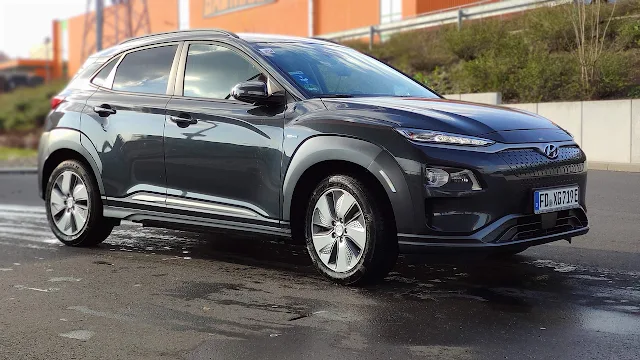Hyundai: A Journey of Innovation and Resilience
From its humble beginnings to becoming a global powerhouse in the automotive industry, Hyundai has charted a path marked by innovation, strategic expansion, and an unwavering commitment to quality. This article delves deep into the history of Hyundai, exploring its evolution, key models, and technological advancements, providing a comprehensive look at a brand that has continuously adapted and thrived in a competitive market.
The Genesis of Hyundai
Founded in 1967 by Chung Ju-yung, Hyundai Motor Company began its journey in an environment ripe with challenges. Initially, Hyundai hired George Turnbull, a former managing director of Austin Morris at British Leyland, who brought in five other top British car engineers to Korea. Their mission was clear from the start: to create a Korean car manufactured by Korean workers, a bold step in a country that at the time had little in the way of automotive production.
Hyundai Car - Image by Michael Schmitt from Pixabay
Hyundai released its first car, the Cortina, in cooperation with Ford Motor Company in 1968. However, it was the introduction of the Hyundai Pony in 1975, South Korea’s first fully homegrown car, that truly put Hyundai on the map. Designed by Giorgio Giugiaro and powered by technology licensed from Mitsubishi, the Pony laid the groundwork for Hyundai's innovative approach to car manufacturing.
Ownership and Global Expansion
Hyundai Motor Company is part of the larger Hyundai Motor Group, which was restructured from the previous conglomerate Hyundai Group in the wake of the 1997 Asian financial crisis. The group also includes Kia Motors and Genesis Motors as key subsidiaries, creating a powerhouse in the automotive sector. Despite the industry's fluctuations and economic downturns, Hyundai has maintained steady growth, largely due to its leadership’s focus on quality, innovation, and diversified global presence.
Model Evolution: From the Pony to the Palisade
Hyundai’s vehicle lineup showcases an impressive evolution from basic models to high-end luxury and electric vehicles. After the Pony, models like the Sonata and the Elantra marked Hyundai's entry into competitive markets with significant success. The Hyundai Sonata, in particular, became synonymous with the brand’s rising reputation for reliability and value in the 1990s.
However, it was the introduction of the Hyundai Santa Fe in 2000 that truly exemplified Hyundai's prowess in understanding and adapting to market trends. The Santa Fe, Hyundai’s first SUV, was a hit in America and became a cornerstone for Hyundai’s reputation as a maker of reliable, feature-rich SUVs.
The Star Performer: Hyundai Elantra
The Hyundai Elantra has been a standout model for Hyundai, consistently delivering strong sales and garnering accolades. Known for its sleek design, efficiency, and packed features at an affordable price point, the Elantra represents Hyundai’s ability to combine performance with value, making it a favorite among consumers worldwide.
Inside Hyundai's Innovation: Car Interiors and Engine Technology
Hyundai’s focus on interiors has aimed to enhance user experience, marrying functionality with comfort. Hyundai interiors are designed to be intuitive, with ergonomic features and advanced technology like smart infotainment systems that support both Android Auto and Apple CarPlay, wireless charging, and advanced navigation systems.
On the engineering front, Hyundai has been a leader in adopting new technologies, including hydrogen fuel cell technology and electric vehicles. The Hyundai Tucson Fuel Cell and the more recent Kona Electric showcase Hyundai’s commitment to alternative energy vehicles, combining eco-friendly technology with practical usability.
Latest Innovations: The Hyundai Ioniq 5
The latest groundbreaking model from Hyundai, the Ioniq 5, represents the next generation of electric vehicles. Launched in 2021, this model is built on Hyundai’s dedicated Electric-Global Modular Platform (E-GMP), which allows for larger interior space, optimized battery placement, and improved driving dynamics. The Ioniq 5 has been praised for its futuristic design, fast charging capabilities, and robust performance, marking a significant milestone in Hyundai's evolution in the electric vehicle segment.
Pricing Strategy: Quality Meets Affordability
Hyundai’s pricing strategy has cleverly positioned the brand as an affordable yet quality-driven option in the automotive market. From the economical Hyundai Accent starting around $15,000 to the more luxurious and technologically advanced Ioniq 5 and Palisade, which can reach up to $45,000, Hyundai offers a wide range of pricing to cater to various market segments while maintaining a focus on value.
Conclusion
Hyundai’s journey from a modest enterprise to a major player in the global automotive industry is a story of resilience, adaptability, and forward-thinking. With a keen eye on future trends and a deep commitment to innovation and quality, Hyundai continues to build cars that offer reliability, state-of-the-art technology, and great value, living up to its promise of "New Thinking, New Possibilities." As Hyundai moves forward, it continues to challenge conventions, setting new benchmarks in automotive excellence and sustainability.







No comments:
Post a Comment